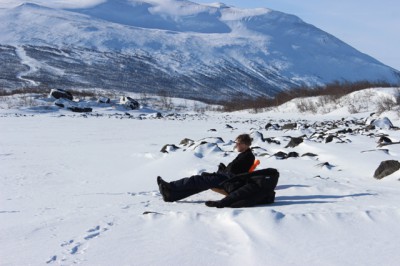Everyone’s aiming for environmentally-friendly tourism these days, and that includes Kiruna. But companies here think they’re doing it already because all the tours are – well, in the environment. And the best thing about this is that it’s now being suggested that these kind of tours should pay less tax.
So when people show up in Kiruna and are rushed out on their northern lights tour, they are, we’re told, being environmentally-friendly. They may choose to begin their tour with a snowmobile trip, sending pollutants in the air as they speed across the frozen river. Or they may have booked to ride behind meat-eating and carbon -producing dogs. Or maybe they’re just driven out to the aurora dome in a car.
Their guide is probably staying here temporarily, from Germany or France, but he’ll have a few stories to tell round the campfire. They’ll sit in something specially constructed for the purpose, for a few hours, and then they’ll be driven back to their hotel. Where they will have a very very long shower to warm themselves, after the cold wait for aurora. They’ll not be around in Kiruna for long – having to move on to the ice hotel, or their next stop – in Iceland perhaps, or London. They’ll have met quite a few other tourists, and got the photos they needed. They may even get the train back to Stockholm (environmentally-friendly) before boarding another flight to their next destination.
It’s sad that this kind of tourism doesn’t even seem to encourage any interest in the local environment. Experiences are delivered in largely artificial ways, often by people who haven’t lived here for very long, and the natural phenomena are packaged in or alongside something basically unnatural.
It doesn’t have to be like that, if we stop encouraging tourists to look for Disneyland and instead help them to see what’s actually here.
Like the annual ice fishing competition recently. A lot of people sitting on the lake in Kiruna in very cold conditions. They have to be three metres apart, so they’re each in their own space in the environment, but they may still manage a conversation with people nearby. Or they’re just sitting, thinking about the fish below the ice. Some of them are lying, their face in the hole, looking for passing fish to tempt with a titbit. Most don’t seem that bothered, though, whether they get a fish or not. They’re at peace with their surroundings.
Every spring we take our small deckchairs out onto the ice on Lake Torneträsk, walking across to a distant spot. The ice is metres thick, and the snow ripples across it where it’s been blown by the wind. We put the chairs on the ice, and sit there. For as long as we can. It’s mostly quiet. We drink coffee. We may call greetings to someone setting up his ice fishing hole nearby. We’ll probably take a walk further across the ice, enjoying the space, the colours, the sensations. Just looking at the landscape, and listening. It’s ice fishing, without killing a fish. It’s as environmentally-friendly, perhaps, as we can get.


